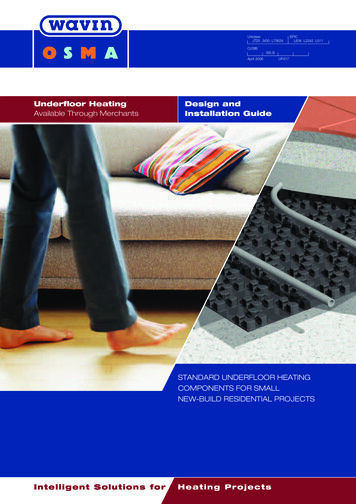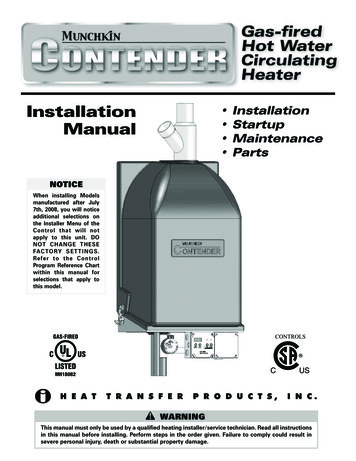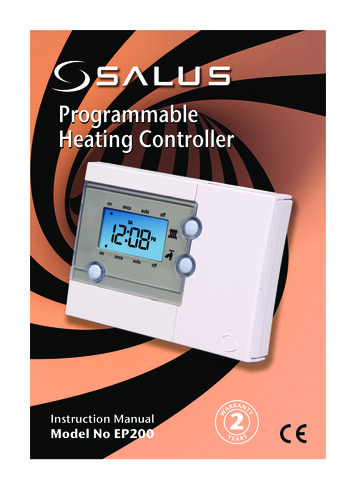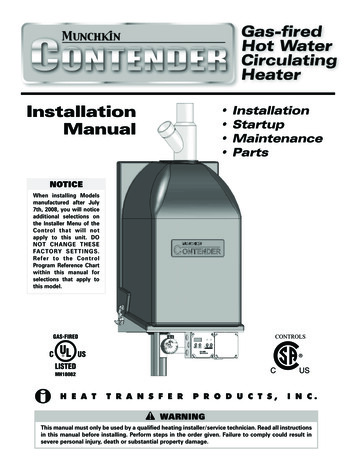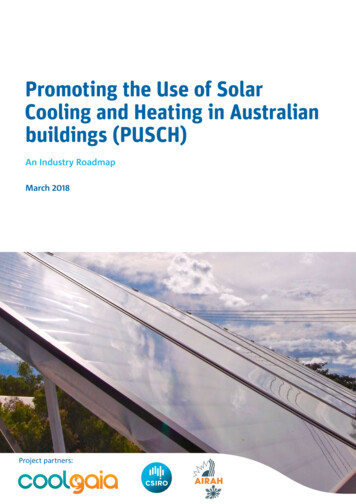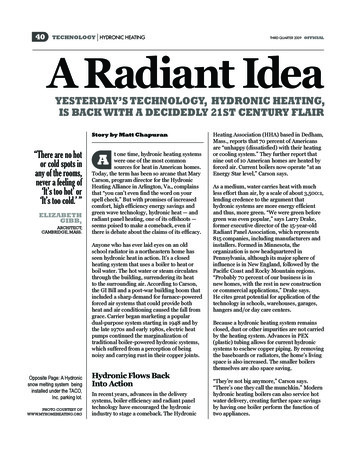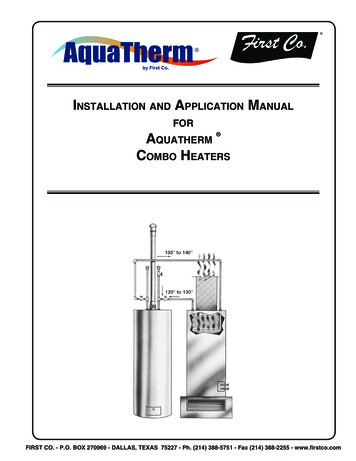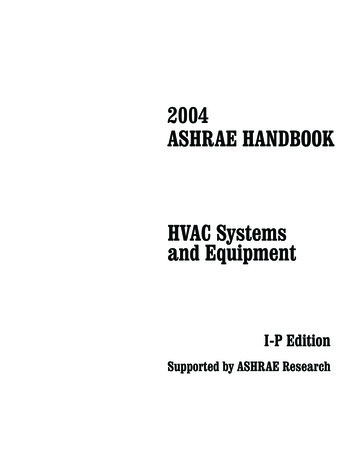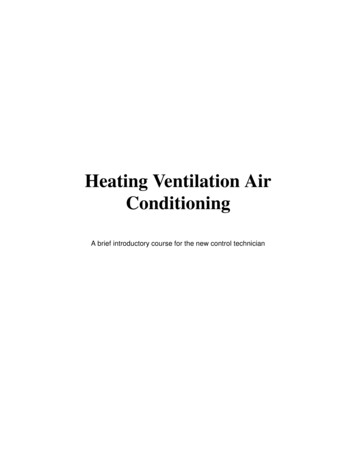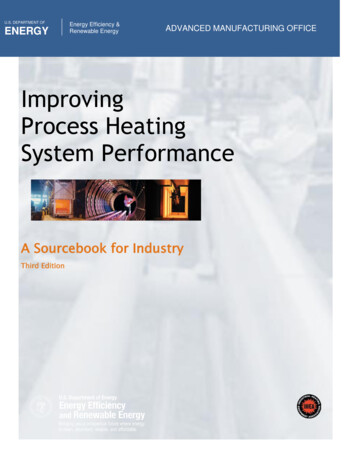
Transcription
U.S. DEPARTMENT OFENERGYEnergy Efficiency &Renewable EnergyADVANCED MANUFACTURING OFFICEImprovingProcess HeatingSystem PerformanceA Sourcebook for IndustryThird Edition
U.S. Department of EnergyEnergy Efficiency and Renewable EnergyBringing you a prosperous future where energy is clean,abundant, reliable, and affordableDisclaimerThis report was prepared as an account of work sponsored by an agency of the United States Government. Neither theUnited States Government nor any agency thereof, nor any of their employees, makes any warranty, express or implied,or assumes any legal liability or responsibility for the accuracy, completeness, or usefulness of any information,apparatus, product, or process disclosed, or represents that its use would not infringe privately owned rights. Referenceherein to any specific commercial product, process, or service by trade name, trademark, manufacturer, or otherwise,does not necessarily constitute or imply its endorsement, recommendation, or favoring by the United StatesGovernment or any agency thereof. The views and opinions of authors expressed herein do not necessarily state orreflect those of the United States Government or any agency thereof.”
ACKNOWLEDGEMENTSImproving Process Heating System Performance: A Sourcebook for Industry is a development of the U.S.Department of Energy (DOE) Advanced Manufacturing Office (AMO) and the Industrial Heating EquipmentAssociation (IHEA). The AMO and IHEA undertook this project as part of an series of sourcebook publicationsdeveloped by AMO on energy-consuming industrial systems, and opportunities to improve performance. Othertopics in this series include compressed air systems, pumping systems, fan systems, steam systems, and motorsand drives.The U.S. DOE, IHEA, Lawrence Berkeley National Laboratory, and Resource Dynamics Corporation wish to thankthe following individuals for their input to this third edition:David Boone, Alabama Power CompanyJoe Cresko, US Department of EnergyDan Curry, Selas Heat TechnologyRobert De Saro, Energy Research CompanyMarc Glasser, Rolled AlloysLeslie Muck, Industrial Heating Equipment AssociationSachin Nimbalkar, Oak Ridge National LaboratoryBill Orthwein, US Department of EnergyWilliam Pasley, Southern CompanyErnesto Perez, Nutec BickleyPaul Sheaffer, Lawrence Berkeley National LaboratoryPerry Stephens, Duke EnergyWe also wish to thank the following individuals for their review and/or input to this and previous editions: B.J.Bernard, Surface Combustion; Tony Carignano, PCT Engineered Systems; Elliott Davis, Selas Heat; Ken Dulaney,EPRI; Brian Kelly, Elster; Tim O'Neal, Selas Heat Technology; Wayne Pettyjohn, Georgia Power; Bruno Purnode,Owens Corning; Steve Sikirica, US Department of Energy; Michael Stowe, Advanced Energy; Arvind Thekdi, E3M,Inc.; Craig Tiras, Gaumer Process; Baskar Vairamohan, EPRI; Devin Wachowiak, Rolled Alloys; and CarstenWeinhold, SCHOTT North America.Third Edition, 2015Prepared for the United States Department of EnergyOffice of Energy Efficiency and Renewable Energy, Advanced Manufacturing OfficeByLawrence Berkeley National Laboratory, Berkeley, CaliforniaResource Dynamics Corporation, McLean, VirginiaIn cooperation with the Industrial Heating Equipment Association, Taylor Mill, KentuckyIMPROVING COMPRESSED AIR SYSTEM PERFORMANCE: A SOURCEBOOK FOR INDUSTRY
FOREWORDThe DOE Office of Energy Efficiency and Renewable Energy (EERE)’s Advanced Manufacturing Office works with industry,small business, universities, and other stakeholders to identify and invest in energy efficient technologies. Reducingenergy consumption through investment in advanced technologies and practices can enhance American manufacturingcompetitiveness.The industrial sector is responsible for about one-third of all U.S. primary energy use, and the associated greenhouse gas(GHG) emissions. The U.S. industrial base is diverse, with about two-thirds of the end-use energy consumed by theenergy intensive industries including chemicals, forest products, petroleum refining, iron and steel, glass, aluminum,metal-casting foundries and cement. Beyond the large energy consumers, there are a wide range of energy dependentindustries whose products and operations are significantly impacted by energy.Of all manufacturing operations, process heating consumes more energy in the U.S. than any other manufacturingsystem – more than 7,000 Trillion Btu (TBtu), or approximately 61% of manufacturing onsite energy use annually.Opportunities to reduce the energy demand for process heat include more efficient heat generation, system design toreduce losses prior to heat use, and alternative manufacturing processes that require less heat to produce the samematerial.This Sourcebook outlines opportunities for energy and performance improvements in process heating systems, and isintended to help the reader identify improvement opportunities in their own facilities. This Sourcebook is not asubstitute for a rigorous engineering-based assessment and evaluation of the technical and economic potential of anyprocess heating improvement. This Guidebook is also intended to serve as a companion to other resources and sourcesof information, such as: The DOE 2015 Quadrennial Technology Review (QTR) Technology Assessments on Process Heating and Waste HeatRecovery, as well as other Technology Assessments that can provide insights into state-of-the-art and emergingopportunities to improve process heat utilization and production efficiencies. AMO’s Steam System Modeling Tool (SSMT), available at http://energy.gov/eere/amo/software-tools. This toolhelp users survey and assess their steam system equipment, perform heat balances, quantify heat losses, andidentify potential energy efficiency upgrades. Fact sheets, technical analyses, roadmaps and other resources that can be found by searching on the AMO“Information Resources” webpage.These and other resources that can help the reader find more information can be found in Section 7 of this Sourcebook– “Where to Find Help.”IMPROVING COMPRESSED AIR SYSTEM PERFORMANCE: A SOURCEBOOK FOR INDUSTRY
CONTENTSQUICK START GUIDESECTION 1: PROCESS HEATING SYSTEM BASICSOVERVIEW. 3EFFICIENCY AND ENERGY INTENSITY OPPORTUNITIES . 3SYSTEMS APPROACH. 4BASIC PROCESS HEATING OPERATIONS . 5COMMON TYPES OF PROCESS HEATING SYSTEMS AND EQUIPMENT . 8SECTION 2: PERFORMANCE IMPROVING OPPORTUNITIES - FUEL-BASED SYSTEMSFUEL-BASED PROCESS HEATING EQUIPMENT CLASSIFICATION . 14EFFICIENCY OPPORTUNITIES FOR FUEL-BASED PROCESS HEATING SYSTEMS . 18TYPES OF ELECTRIC-BASED PROCESS HEATING SYSTEMS – DIRECT AND INDIRECT . 25SECTION 3: PERFORMANCE IMPROVING OPPORTUNITIES - ELECTRIC-BASED SYSTEMSARC FURNACES. 26ELECTRIC INFRARED PROCESSING. 28ELECTRON-BEAM PROCESSING . 32INDUCTION HEATING AND MELTING . 34LASER PROCESSING . 36MICROWAVE PROCESSING . 37PLASMA PROCESSING (ARC AND NONTRANSFERRED ARC) . 39RADIO-FREQUENCY PROCESSING . 40RESISTANCE HEATING AND MELTING . 40ULTRAVIOLET PROCESSING . 43SUMMARY OF ELECTROTECHNOLOGIES FOR PROCESS HEATING . 45SECTION 4: WASTE HEAT MANAGEMENT - REDUCTION, RECYCLING AND RECOVERYTYPICAL WASTE HEAT STREAMS IN PLANT OPERATIONS . 46WASTE HEAT MANAGEMENT . 48BARRIERS TO WASTE HEAT MANAGEMENT . 54GENERAL GUIDELINES AND CONSIDERATIONS FOR WASTE HEAT MANAGEMENT . 54SECTION 5: PROCESS HEATING SYSTEM ECONOMICSUNDERSTANDING CORPORATE PRIORITIES . 57MEASURING THE DOLLAR IMPACT OF EFFICIENCY . 57PRESENTING THE FINANCIAL BENEFITS OF EFFICIENCY . 58RELATING EFFICIENCY TO CORPORATE PRIORITIES. 58SECTION 6: SUSTAINABILITY OF PROCESS HEATING SYSTEMSSustainable Manufacturing . . .56IMPROVING COMPRESSED AIR SYSTEM PERFORMANCE: A SOURCEBOOK FOR INDUSTRY
SECTION 7: WHERE TO FIND HELPADVANCED MANUFACTURING OFFICE. 62DIRECTORY OF CONTACTS . 63RESOURCES AND TOOLS . 65BOOKS . 65OTHER PUBLICATIONS (GUIDES, MANUALS, AND STANDARDS) . 67SOFTWARE . 67PERIODICALS . 69REPORTS AND TECHNICAL PAPERS . 69TRAINING COURSES AND TECHNICAL SERVICES. 69APPENDICESAPPENDIX A: GLOSSARY OF TERMS . 72APPENDIX B: PROCESS HEATING TIP SHEETS . 77TIP SHEET 1: PREHEATED COMBUSTION AIR. 78TIP SHEET 2: CHECK BURNER AIR TO FUEL RATIOS . 80TIP SHEET 3: OXYGEN-ENRICHED COMBUSTION. 82TIP SHEET 4: CHECK HEAT TRANSFER SURFACES . 84TIP SHEET 5: REDUCE AIR INFILTRATION IN FURNACES . 86TIP SHEET 6: FURNACE PRESSURE CONTROLLERS . 88TIP SHEET 7: REDUCE RADIATION LOSSES FROM HEATING EQUIPMENT . 90TIP SHEET 8: INSTALL WASTE HEAT RECOVERY SYSTEMS FOR FUEL-FIRED FURNACES . 92TIP SHEET 9: LOAD PREHEATING USING FLUE GASES FROM A FUEL-FIRED HEATING SYSTEM . 94TIP SHEET 10: USING WASTE HEAT FOR EXTERNAL PROCESSES . 96TIP SHEET 11: USE LOWER FLAMMABLE LIMIT MONITORING EQUIPMENT TO IMPROVE PROCESS OVEN EFFICIENCY . 98APPENDIX C: TECHNICAL BRIEFS . 100APPENDIX D: REFERENCES . 115IMPROVING COMPRESSED AIR SYSTEM PERFORMANCE: A SOURCEBOOK FOR INDUSTRY
FIGURESFigure 1. A fuel-based process heating system and opportunities for improvement . 13Figure 2. Energy loss diagram in a fuel-based process heating system . 16Figure 3. Key opportunities in a fuel-based system . 17Figure 4. Simple schematic of an electric infrared heating system . 27Figure 5. Waste heat recyclingoptions .46Figure 6. Waste heat recoveryconcept .47TABLESTable 1. Examples of process heating operations . 8Table 2. Process heating equipment classification . 14Table 3. Infrared emitters by wavelengthcategory .28Table 4. Summary of electrotechnologies for process heating 42Table 5. Temperature range and characteristics for industrial waste heat sources . 43Table 6. Commonly used waste heat management systems, by temperature range . 49Table 7. Emerging or developing waste heat management technologies, by temperature range . 50IMPROVING COMPRESSED AIR SYSTEM PERFORMANCE: A SOURCEBOOK FOR INDUSTRY
QUICK START GUIDEThis sourcebook describes basic process heating applications and equipment, and outlines opportunities for energy andperformance improvements. It also discusses the merits of using a systems approach in identifying and implementingthese improvement opportunities. It is not intended to be a comprehensive technical text on improving process heatingsystems, but serves to raise awareness of potential performance improvement opportunities, provides practicalguidelines, and offers suggestions on where to find additional help. The sourcebook contains information in thefollowing sections:Section 1: Process Heating BasicsFor users unfamiliar with the basics of process heating systems, or for users seeking a refresher, a brief discussion of theequipment, processes, and applications is provided.Section 2: Performance Improvement Opportunities—Fuel-Based SystemsThis section discusses key factors for improving the performance of fuel-based process heating systems. This section iscategorized by opportunity type: 1) heat generation; 2) heat containment; 3) heat transfer; 4) waste heat recovery; and5) enabling technologies.Section 3: Performance Improvement Opportunities—Electric-Based SystemsThis section discusses key factors for improving the performance of electric-based process heating systems. Electricbased solutions and opportunities are described by technology type.Section 4: Waste Heat Management – Reduction, Recycling and RecoveryThis section describes different methods for managing and utilizing the various forms of waste heat that can begenerated by process heating systems.Section 5: Process Heating System EconomicsTo support the improvement opportunities presented in Sections 2 through 4, this section provides recommendations tofinancially justify process heating improvement projects.Section 6: Sustainability of Process Heating SystemsThis section addresses the growing concern of sustainability, how it is related to industrial energy consumption, and whyimproving the sustainability of process heating systems will be beneficialSection 7: Where to Find HelpIn addition to a comprehensive listing of resources and tools, this section contains a directory of associations and otherorganizations engaged in enhancing process heating system efficiency.AppendicesAppendix A is a glossary defining terms used in process heating systems. Appendix B contains a series of process heatingsystem tip sheets. Developed by DOE, these tip sheets discuss additional opportunities for improving the efficiency andperformance of process heating systems. Appendix C contains technical briefs developed by DOE. These technical briefsdiscuss specific performance improvement topics in more detail than the tip sheets. Appendix D is a compendium ofreferences used in the development of this sourcebook.IMPROVING PROCESS HEATING SYSTEM PERFORMANCE: A SOURCEBOOK FOR INDUSTRY 2
SECTION 1: PROCESS HEATING SYSTEM BASICSOverviewProcess heating is essential in the manufacture of mostconsumer and industrial products, including those madeout of metal, plastic, rubber, carbon fiber, concrete,glass, and ceramics. Process heating systems can bebroken into three basic categories:Fuel-Based Process HeatingWith fuel-based systems, heat is generated by thecombustion of solid, liquid, or gaseous fuel, andtransferred either directly or indirectly to the material.The combustion gases can be either in contact with thematerial (direct heating), or be confined and thus beseparated from the material (indirect heating, e.g.,radiant burner tube, retort, muffle). Examples of fuelbased process heating equipment include furnaces,ovens, kilns, lehrs, and melters. Within the UnitedStates, fuel-based process heating (excluding electricityand steam generation) consumes 5.2 quads of energyannually1, which equals roughly 17% of total industrialenergy use. Typically, the energy used for processheating accounts for 2% to 15% of the total productioncost.2Electric-Based Process HeatingElectric-based process heating systems (often calledelectrotechnologies) use electric currents orelectromagnetic waves to heat materials. Direct heatingmethods generate heat within the work piece itself, byeither (1) passing an electrical current through thematerial, (2) inducing an electrical current (eddycurrent) into the material, or (3) exciting atoms and/ormolecules within the material with electromagneticfields (e.g., Radio frequency (RF), Microwave (MW).Indirect heating methods use one of these threemethods to apply heat to the work piece surface or to asusceptor material which transfers the heat to the work1A quad is a unit of energy equal to 1 quadrillion Britishthermal units.2 Roadmap for Process Heating Technology: Priority Research& Development Goals and Near-Term Non-Research Goals Topiece by either conduction, convection, radiation, or acombination of these.Steam-Based Process HeatingSteam systems, covered in a separate sourcebook,account for about 30% of the total energy used inindustrial applications for product output. Thesesystems can be indispensable in delivering the energyneeded for process heating, pressure control,mechanical drives, separation of components, andproduction of hot water for process reactions. Steamhas several favorable properties for process heatingapplications. Steam holds a significant amount ofenergy on a unit mass basis (between 1,000 and 1,250British thermal units per pound [Btu/lb]). Since most ofthe heat content of steam is stored as latent heat, largequantities of heat can be transferred efficiently at aconstant temperature, which is a useful attribute inmany process heating applications. Steam-basedprocess heating has low toxicity, ease oftransportability, and high heat capacity. For moreinformation on steam process heating systems, see theDOE sourcebook Improving Steam System Performance:A Sourcebook for Industry.Hybrid systems use a combination of process heatingsystems by using different energy sources or differentheating methods of the same energy source. Infrared, incombination with a convection oven is a hybrid system.A paper- drying process that combines infraredtechnology with a steam-based drum dryer is also ahybrid system.Efficiency and Energy IntensityOpportunitiesEnergy efficiency refers to the activity or product thatcan be produced with a given amount of energy; forexample, the number of tons of steel that can bemelted with a megawatt hour of electricity. EnergyImprove Industrial Process Heating, Industrial HeatingEquipment Association, U.S. Department of Energy, CapitalSurini Group International, Inc., Energetics, Inc., 2001.IMPROVING PROCESS HEATING SYSTEM PERFORMANCE: A SOURCEBOOK FOR INDUSTRY 3
1 – PROCESS HEATING SYSTEM BASICSIntensity is measured by the quantity of energy requiredper unit output or activity, so that using less energy toproduce a product reduces the intensity. In thisexample, energy intensity is the number of megawatthours used to melt one ton of steel. The differencebetween efficiency and energy intensity is insignificant,as one is simply the inverse of the other. Having a goalto improve efficiency or reduce energy intensity putsyou on the correct path for process improvements.Approaches to improve a certain heating operationmight be applicable to multiple processes To identifysynergies and encourage improvements by technologyand knowledge transfer, opportunities common toindustry segments, applications, and, where possible,equipment type, are identified in this sourcebook.References to further reading and other informationsources are given where appropriate.In some cases, a process heating requirement can beeliminated altogether. For example, there is a currenttrend to use chemicals that do not require heating to beeffective in washing systems used to clean metals partsprior to painting operations.Many companies focus on productivity related issues.While productivity and output are clearly important,significant energy cost savings are also achievable inindustrial process heating systems, and theseopportunities are often overlooked. One of the goals ofthe sourcebook is to build awareness of the economicbenefits resulting from the improvement of the energyefficiency of these systems.Since process heating system performance isfundamental to the quality of a wide range of finishedproducts, efficiency and performance must beconsidered together. In order to identify systemimprovement opportunities, it is helpful to understandsome common losses and avoidable costs. Performanceimprovement opportunities are described in Sections 2through 4, in the tip sheets in Appendix B, and in thetechnical briefs in Appendix C. The reader is alsoencouraged to seek greater technical detail in otherresources, such as those listed in the “Where to FindHelp” section. Due to a wide range of operatingcharacteristics and conditions, the guidelines andrecommendations given in the sourcebook tend to befairly general. The intent is to help industry identify andprioritize potential improvement opportunities, andimplement projects that are technically andeconomically feasible.Systems ApproachDepending on the process heating application, systemsizes, configurations, and operating practices differwidely throughout industry. For a given system, thereare usually a variety of improvement opportunities. Inorder to achieve maximum improvement at the lowestcost both, a systems approach and individualcomponent analyses should be used.A systems approach provides a tops-down review of theentire process and how the individual componentsperform and interact with each other. An importantpart of this approach is to create process flow diagramswhich show the movement of materials and energythroughout the system. This not only gives a birds-eyeview of the entire process but also allows the ranking ofcomponents according to their importance forefficiency opportunities, and how changing onecomponent may affect the others. Most importantly,the exercise highlights the confidence in the data andtherefore what additional measurements are needed.Next, the individual components, determined to be themost important from the system's approach, arecarefully analyzed to determine their detailedperformance and ways to improve their efficiency.Finally, an iterative step is taken in which thecomponent's new performance is fed back to thesystem's approach analysis to determine the trueimprovements when interactions among all thecomponents are evaluated.The benefits of a systems approach can be illustratedthrough the following example. Operators often focuson the immediate demands of a particular process step,but underestimate the effects of a particular setting onthe long-term performance of the equipment, or otherprocesses downstream. A systems approach would takethose effects into account, and weigh them against eachother to achieve optimum overall performance. Theoperator might notice a product problem related totemperature and might make an adjustment as a quickfix instead of finding the root cause in the system, suchas poor insulation.IMPROVING PROCESS HEATING SYSTEM PERFORMANCE: A SOURCEBOOK FOR INDUSTRY 4
1 – PROCESS HEATING SYSTEM BASICSPoor insulation might reduce a process heating system’sefficiency, thereby increasing the amount of energyneeded to perform a given process heating task. Inaddition to an increased cost for energy, the system isexposed to higher stress, which can accelerate wear andsubsequently lead to more frequent breakdowns. Otherside effects can be reduced product quality andincreased maintenance.removal of excess water from raw materials for themanufacture of specialty optical materials and glasses.Other examples are short-term fixes, includingreplacements and routine maintenance, which mightrequire multiple partial upgrades of an aginginfrastructure. Short-term fixes can increase thecomplexity of a system, lower its reliability, andeffectively block improvements that have the potentialto lead to substantial long-term gains.Basic Process Heating OperationsProcess heating is used in many industries for a widerange of applications, which often comprise multipleheating operations. The manufacture of steel ofteninvolves a c
the following individuals for their input to this third edition: David Boone, Alabama Power Company Joe Cresko, US Department of Energy Dan Curry, Selas Heat Technology . Third Edition, 2015 . as well as other Technology Assessments that can provide ins
